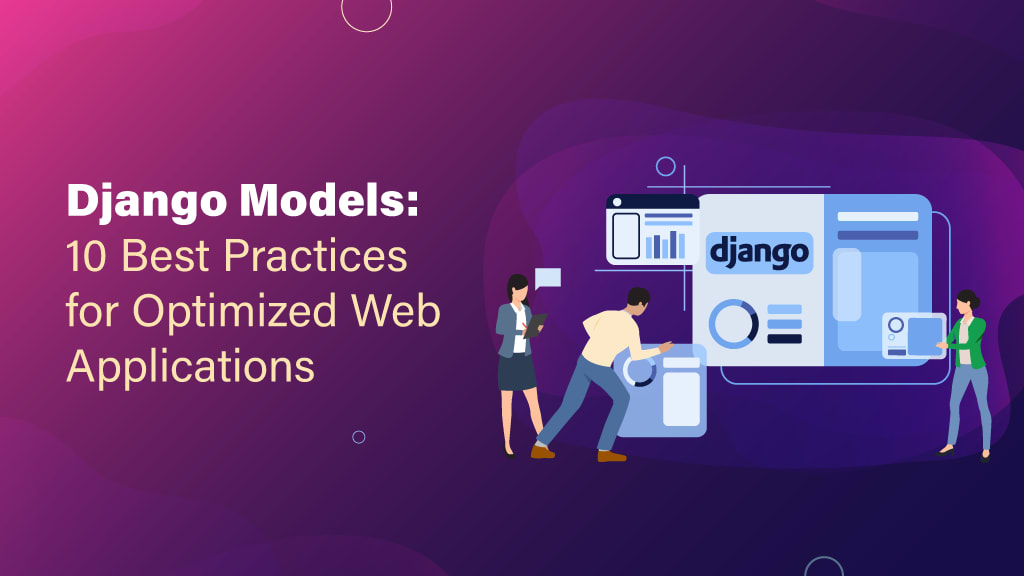Django Models: 10 Best Practices for Optimized Web Applications
10 Best Practices for Developing Optimized Web Applications with Django Models

Django is a high-level Python-based web framework that empowers developers to build robust, scalable web applications efficiently. Django offers a straightforward and practical web development approach that enables developers to simplify coding complexities. Django models are the essential building blocks defining your application's data structure. These models link between your data and your application. These models allow you to create, retrieve, update, and delete records on your application easily and efficiently.
However, the ease and efficiency of a Django model depend upon its design. Well-designed models lead to cleaner code, easier maintenance, and fewer bugs. All these directly impact the stability and performance of your applications. Therefore, understanding and implementing the best practices in Django model design is essential for robust, scalable, and future-proof applications for your businesses. Explore and implement the best practices below to witness optimization in your development process.
What are Django Models?
Django models are the core components developers work with during Django application development. These models serve as the crucial blueprint for your data structure. Furthermore, these models play a vital role in the architecture of your application, acting as the definitive source of information about your data. They detail what data is stored and how it's represented to other parts of your application, ensuring consistency and reliability in your business operations.
Key Components of Django Models
A Django model is composed of several key components, each serving a specific purpose:
- Fields: These are the building blocks of Django models. Fields define each model's data type, like text, numbers, dates, or relationships to other models. Specifying your data types with fields ensures that your data adheres to your business rules and expectations.
- Metadata: Think of metadata as the settings for your model. It is where you provide Django with special behavior instructions, such as ordering options, database table names, or human-readable singular and plural names for your model.
- Methods: Methods refer to the components that enable Django developers to define custom behavior or logic for their models. They allow you to write functions for handling tasks like how a model should display itself as a string or custom methods to perform operations specific to your business needs.
- ORM: ORM (Object-Relational Mapping) in Django is a powerful feature that transforms your model definitions into database queries. The ORM converts Python code into SQL, the language that databases understand. This means you don't have to write complex SQL queries manually. Instead, you can work with your Django models using Python, making database operations more intuitive and less error-prone. The ORM abstracts these operations, allowing you to focus on crafting your application's unique features, ensuring a smoother and more efficient development process.
10 Django Models Best Practices to Consider
1. Planning Your Models
Before coding, you must lay a solid foundation for your Django models. Thoughtful planning sets the stage for efficient and effective custom Django development. Furthermore, it ensures your application is functional, scalable, and maintainable.
The following steps can help plan your models for robust application development.
- Understanding business requirements: Learn about your business's core functionalities and rules to ensure your models accurately reflect and support these needs.
- Using ER diagrams: Employ Entity-Relationship (ER) diagrams to visualize and define the relationships between different data entities, fostering a clear, logical database structure.
- Defining clear naming conventions: Choose intuitive and consistent names for models and fields. Clear naming enhances code readability and maintainability.
- Organizing models into apps: Strategically divide your project into smaller, focused apps, grouping related models for better modularity and reusability.
2. Selecting and Validating Fields in Django Models
Field selection and validation are cornerstone practices in custom Django development, directly impacting your application's integrity, performance, and security. Proper field selection ensures that data is stored efficiently and accurately, while validation enforces business rules and data consistency, safeguarding your application from erroneous or harmful data inputs. Follow the steps stated below to select and validate fields effectively.
- Choosing appropriate field types: Django developers should carefully select field types that best represent the data, optimizing storage and performance. For instance, use ‘IntegerField’ for whole numbers or ‘CharField’ for short text strings.
- Implementing built-in validators: Utilize Django's built-in validators to enforce data integrity, such as ‘max_length’ for string fields or ‘email’ for email fields, ensuring data adheres to expected formats.
- Creating custom validators: When built-in validators aren't sufficient, create custom validation functions to enforce specific business rules, providing additional data integrity and business logic.
- Using field options: Understand and properly use fields like ‘null’, ‘blank’, and ‘default’ to control how fields behave regarding database storage and form rendering, ensuring they align with your application's needs.
3. Defining Relationships between Django Models
Defining relationships between models is a critical aspect of Django application development. These relationships process the complex interconnections of real-world data within your application. Properly structured relationships ensure data consistency, enhance query efficiency, and reflect a clear understanding of how different data entities interact with one another. Professional Django developers follow the best practices given below for defining relationships between models:
- Understanding relationship types: Learn Django's relationship fields – ‘ForeignKey’ for one-to-many, ‘ManyToManyField’ for many-to-many, and ‘OneToOneField’ for one-to-one relationships. Choose the one that best represents the real-world relationship between your data entities.
- Using related names: Specify meaningful 'related_name' attributes when defining relationships. This enhances code readability and provides a clear way to access related data from the opposite side of the relationship.
- Considering database indexing: For relationships that will be frequently queried, ensure proper database indexing is in place. This improves query performance, which is especially important as your application scales.
- Avoiding circular dependencies: Be cautious of circular dependencies between models, which can complicate your database schema and application logic. Structure your models to minimize unnecessary interdependencies.
Adhering to these best practices when defining relationships between Django models sets a strong foundation for your application's data structure. You may hire Django developers proficient in these practices to define robust, intuitive, and performance-optimized data relationships for your application.
4. Writing Custom Model Methods and Managers
Writing custom model methods and managers is a powerful feature of the Django web application framework. This feature enhances the functionality and reusability of your models. Custom methods and managers allow developers to encapsulate business logic within the models. This promotes cleaner code and makes complex data operations more accessible and maintainable throughout the application.
The listed best practices ensure clean codes while writing custom methods and managers:
- Keeping business logic in models: Implement custom methods within your models to handle business-specific logic, ensuring that this logic stays consistent and manageable.
- Using managers for common query sets: Define custom managers when you repeatedly write the same query sets. Managers provide a namespace for your custom query sets, making your codebase more organized and your queries more reusable.
- Maintaining readability and simplicity: Write clear and concise custom methods and managers. Avoid overly complex functions and keep them focused on a single task to enhance readability and ease of maintenance.
5. Optimizing Database Queries
Optimizing database queries is essential to enhancing the performance and scalability of applications built on Django architecture. Understanding how Django executes queries and the significance of optimizing them can drastically reduce server load, improve response times, and provide a smoother user experience. Effective query optimization ensures that your application remains robust and efficient even as it grows in complexity and size.
The following best practices offer the correct approach to optimizing your database:
- Understanding query execution: Learn how Django constructs and executes queries. This understanding allows you to develop more efficient queries and recognize potential performance bottlenecks.
- Utilizing ‘select_related’ and ‘prefetch_related’: Minimize database hits by using ‘select_related’ for forward foreign key relationships and ‘prefetch_related’ for many-to-many and reverse foreign key relationships. These tools efficiently fetch related objects in fewer database queries.
- Implementing database indexing: Use database indexing on fields that are frequently queried. Indexing these fields can significantly speed up query execution times, especially for larger datasets.
- Avoiding the N+1 query problem: Be mindful of the N+1 query issue, where you inadvertently make a separate database query for each item in a dataset. Use ‘select_related’ and ‘prefetch_related’ to fetch all related data in a single query.
6. Ensuring Django Model Security
Securing models is critical to developing robust applications using Django models. You must protect sensitive data and safeguard against vulnerabilities as it maintains the integrity and confidentiality of the data and promotes trust among users. Implementing the following robust security measures at the model level prevents potential breaches and keeps your application resilient against common threats.
- Implementing field encryption: Encrypt sensitive fields in your models, such as personal information or confidential data, to protect them from unauthorized access or exposure. Use robust encryption algorithms and manage keys securely.
- Securing password storage: Never store passwords as plain text. Use Django's built-in authentication system, which uses strong hashing algorithms to handle user passwords securely by default.
- Validating and sanitizing input: Ensure all data input is validated and sanitized to prevent SQL injection attacks using Django's ORM and forms. These tools automatically escape SQL queries and avoid such vulnerabilities.
- Limiting data exposure: Apply the principle of least privilege by only exposing necessary data. Use Django's built-in permissions and queryset filtering to control data access based on user roles or permissions.
- Updating dependencies regularly: Keep all components of your Django project, including third-party packages, up-to-date. Regular updates ensure your application has the latest security patches and protections against known vulnerabilities.
7. Testing Django Models
Testing your Django models ensures your application behaves as expected and remains safe against bugs and errors. It validates the functionality and integrity of your models and facilitates smoother updates and maintenance. This further safeguards against introducing new issues while modifying the code.
Follow the best practices stated below for testing your Django models effectively:
- Writing comprehensive unit tests: Create thorough unit tests for each model to test individual pieces of logic in isolation. Ensure that each field, method, and model behavior is covered, validating that your models behave as expected.
- Incorporating integration tests: Beyond unit tests, implement integration tests to check how your application's parts work together. These tests ensure that the interaction between your Django models and other components (like views and templates) functions correctly.
- Using Django's testing framework: Take advantage of Django's built-in testing tools specifically tailored for testing Django models and applications. This includes using the ‘TestCase’ class to create test cases and the test database to isolate test runs from your production data.
- Automating your testing process: Automate your tests to run with every code commit or before deployments. Tools like CI/CD pipelines can help you run your tests automatically. These tools verify every change and reduce the chances of introducing errors.
8. Utilizing Abstract Models
Using abstract models in Django can help create a DRY (Don't Repeat Yourself) codebase, promote code reuse, and maintain consistency across your application. Abstract models define common fields and methods in a single place and then extend them to other models. This approach streamlines your code and simplifies maintenance and updates, as changes to the base model automatically propagate to all inheriting models.
You may follow the best practices for using abstract models effectively:
- Identifying common patterns: Look for patterns and commonalities in your data and behavior across different models. Abstract models can benefit when multiple models share the same fields or methods.
- Defining base fields and methods: In your abstract model, define the common fields and methods across your child models. This might include common fields like ‘created_at’ and ‘updated_at’ or common methods for formatting or processing data.
- Using meta options: Ensure to keep the ‘abstract = True’ setting in the Meta class of your abstract model. This tells Django that the model is an abstract base class and should not be created as a database table.
- Extending abstract models: When creating child models, inherit from your abstract base model to bring in the shared fields and methods. Be mindful of the inheritance hierarchy and keep it as simple and linear as possible to avoid complexity.
9. Using Multi-table Inheritance
It would help if you used multi-table inheritance in Django when you have a common set of base fields and behaviors across multiple models. However, each model also needs its unique fields and methods. This feature allows linking each model in the inheritance hierarchy to its own database table. This enables specialized behavior while maintaining a clear, hierarchical relationship between entities. Multi-table inheritance simplifies complex data structures, making your application more intuitive and easier to extend.
To implement multi-table inheritance effectively, you may follow the best practices listed below:
- Using sparingly: Employ multi-table inheritance only when necessary. Despite being powerful, this tool adds complexity to your database structure and can affect performance due to the need for additional joins.
- Understanding the database implications: Recognize that each class in a multi-table inheritance hierarchy will correspond to its database table. Be aware of the impact this may have on database performance and structure.
- Defining parent and child models clearly: Ensure that your base (parent) model encapsulates common fields and behaviors. In contrast, child models extend the base model with fields and methods specific to them.
- Optimizing queries: Be conscious of how you query models that use multi-table inheritance. You can decrease the database query count by utilizing methods like 'select_related' to mitigate performance issues.
10. Using Popular Django Packages and Extensions
Using notable Django packages and extensions can significantly enhance your application's capabilities. Furthermore, these packages and extensions offer advanced functionalities and features beyond the core framework.
These Django packages, developed and maintained by the community, can significantly accelerate development time, introduce proven solutions to common problems, and keep your application up-to-date with the latest technological trends. However, choosing these Django packages and ensuring they are reliable, well-maintained, and secure is crucial.
To reduce your effort, we have provided a list of the most popular packages and extensions for optimized web applications:
- Django REST framework: This powerful and flexible toolkit helps build Web APIs. Django REST framework offers features like serialization, authentication, and extensive documentation.
- Celery: Celery is an asynchronous task/job queue based on distributed message passing. It is ideal for handling real-time operations and background tasks.
- Allauth: Allauth is a comprehensive package providing authentication, registration, account management, and third-party (social) account integration.
- Debug Toolbar: Django's Debug Toolbar is a configurable set of panels that display debug data about the current request/response, immensely useful for development and debugging.
- Crispy Forms: Crispy Forms helps manage Django forms and renders them in a DRY, clean, and time-saving way, with various style options.
- Haystack: Modular search for Django. It abstracts the way you can add search functionality to your site. Furthermore, it supports multiple backends like Solr, Elasticsearch, and Whoosh.
Conclusion
This guide has explored the essential best practices for strengthening your Django models and advancing your business's digital initiatives. Implementing these strategies ensures the development of robust, efficient, and secure Django applications. Furthermore, it sets a high standard in today's competitive market.
We encourage business leaders like you to understand and actively implement these best practices. Doing so positions your Django application at the forefront of technological excellence. Therefore, step into the future of business-oriented application development with the insights and practices that will make your Django projects succeed.
About the Creator
Nicholas Winston
Working as an IT Manager in a reputed Digital Transformation and Software Solution Company in India. Being a technical writing enthusiast, I have served in the Information technology, Services, and Product industry.






Comments
There are no comments for this story
Be the first to respond and start the conversation.